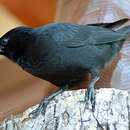en
names in breadcrumbs


The chopi blackbird (Gnorimopsar chopi) is a species of bird in the family Icteridae. It is monotypic within the genus Gnorimopsar.[2] It is found in Argentina, Bolivia, Brazil, Paraguay, Peru, and Uruguay. Its natural habitats are dry savanna, subtropical or tropical seasonally wet or flooded lowland grassland, pastureland, and heavily degraded former forest.[1]
The chopi blackbird is 25 cm (9.8 in) in length and has black plumage across the body. It is similar to the Forbes's blackbird but has a slightly curved bill with a groove along the lower mandible. The call is a loud explosive "tjouw", either given as a single call or as a series that vary randomly in pitch.[3]
The diet of this species is poorly known, but they have been observed feeding on arthropods and fruit, and there are recorded instances of them feeding on frogs and even preying on birds.[4]
The chopi blackbird (Gnorimopsar chopi) is a species of bird in the family Icteridae. It is monotypic within the genus Gnorimopsar. It is found in Argentina, Bolivia, Brazil, Paraguay, Peru, and Uruguay. Its natural habitats are dry savanna, subtropical or tropical seasonally wet or flooded lowland grassland, pastureland, and heavily degraded former forest.
The chopi blackbird is 25 cm (9.8 in) in length and has black plumage across the body. It is similar to the Forbes's blackbird but has a slightly curved bill with a groove along the lower mandible. The call is a loud explosive "tjouw", either given as a single call or as a series that vary randomly in pitch.
The diet of this species is poorly known, but they have been observed feeding on arthropods and fruit, and there are recorded instances of them feeding on frogs and even preying on birds.